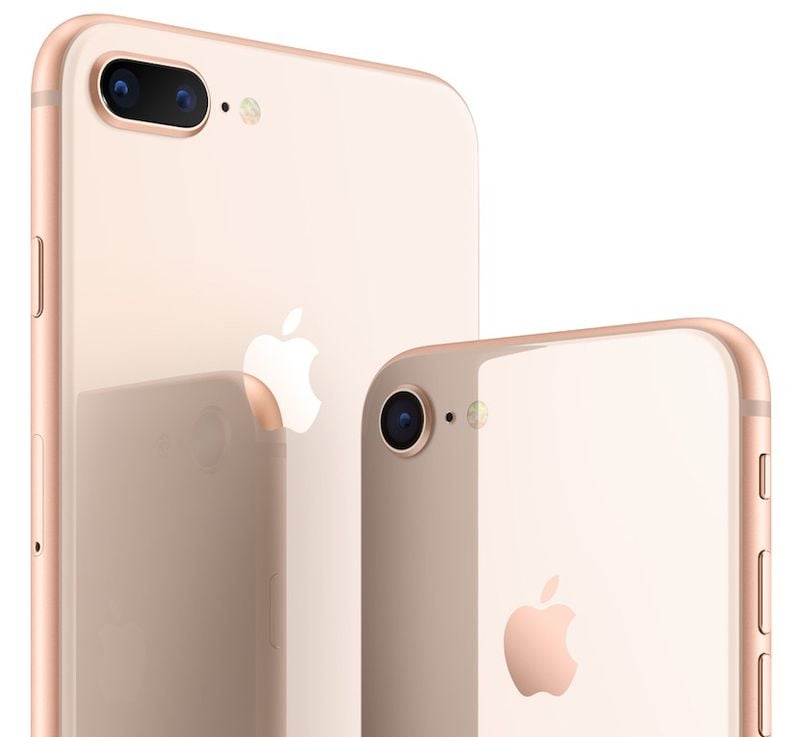
iPhone 8 Discontinued and Replaced with iPhone SE
Apple in April 2020 launched a new low-cost iPhone, the 2020 iPhone SE, as a replacement for the iPhone 8. Despite the name, the iPhone SE features the same design as the iPhone 8 but with upgraded internals that include the same A13 chip as the iPhone 11, 11 Pro, and 11 Pro Max.
The iPhone SE is priced starting at $399, and with its debut, Apple has discontinued the iPhone 8 and the iPhone 8 Plus. For more on the iPhone SE, make sure to check out our iPhone SE roundup.
iPhone 8 and iPhone 8 Plus Specs and Features
Contents
Introduced on September 12, 2017, the iPhone 8 and the iPhone 8 Plus represented a "huge step forward for the iPhone," according to Apple CEO Tim Cook. The two devices "improve on everything we love about iPhone" with overhauled internals and a tweaked design, but the changes introduced were not as dramatic as the changes brought to the iPhone X, launched alongside the iPhone 8 and iPhone 8 Plus.
The iPhone 8 and iPhone 8 Plus mix a little bit of the iPhone X with a little bit of the previous-generation iPhone 7 and iPhone 7 Plus. The overall design is the same as previous-generation devices, but the iPhone 8 and the iPhone 8 Plus adopted glass bodies sandwiched in a a matching aluminum frame. Unlike the iPhone X, the iPhone 8 continued to include Touch ID Home button and thick bezels at the top and bottom of the display.
Presently available in three colors, Silver, Space Gray, and Gold, the iPhone 8 and the iPhone 8 Plus featured the most durable glass ever in a smartphone in a reinforced steel and aluminum structure that is IP67 water and dust resistant. The stereo speaker setup in the device was updated to be 25 percent louder with deeper bass.
The iPhone 8 includes a 4.7-inch display, while the iPhone 8 Plus features a larger 5.5-inch display. Both displays were upgraded with True Tone support, designed to adapt color temperature and intensity to the ambient light in a room for a more natural, paper-like viewing experience. 3D Touch and P3 wide color support for a greater range of colors continue to be available.
Apple chose glass for the body of the iPhone 8 and the iPhone 8 Plus to enable a Qi-based inductive wireless charging feature, which allows the two devices to be charged when placed atop any Qi-certified inductive charger.
Inside the iPhone 8 and iPhone 8 Plus, there's a six-core A11 Bionic chip, which Apple at launch said was the smartest, most powerful chip ever introduced in a smartphone. There are two performance cores that are 25 percent faster than the A10 Fusion chip in the iPhone 7, and four efficiency cores that are 70 percent faster.
With a second-generation performance controller, all six cores can be harnessed at the same time for much improved speeds when handling multi-threaded workloads. There's an Apple-designed 3-core GPU that's 30 percent faster than the previous-generation GPU, and two of the cores, the Neural Engine, make machine learning tasks faster than ever before.
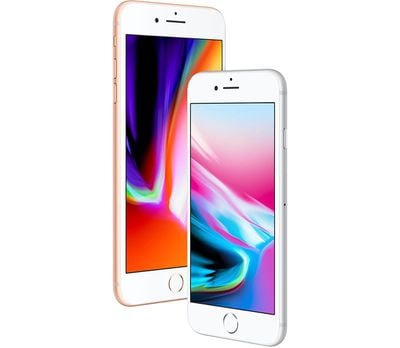
Both the iPhone 8 and the iPhone 8 Plus feature improved cameras with better sensors that let 83 percent more light into the wide-angle camera compared to the previous generation. There's also a upgraded image signal processor built into the A11 that brings better low light performance, including faster autofocus, and there are new pixel processing techniques for sharpness pixel texture.
Apple also added hardware-enabled multi-band noise reduction, deeper pixels, and a new color filter for less noise, better color saturation, and a wider dynamic range of color.

The larger iPhone 8 Plus continues to offer a dual-lens camera setup with both an f/2.8 telephoto lens and a f/1.8 wide-angle lens, both of which have upgraded sensors. Optical image stabilization continues to be available for the iPhone 8 and the wide-angle lens in the iPhone 8 Plus.
Apple's Portrait Mode, limited to the iPhone 8 Plus's dual-lens camera system, has been updated with a Portrait Lighting effect to dynamically change the lighting in an image to mimic studio lighting techniques.
With the upgraded image signal processor and an Apple-designed video encoder that enables faster video frame rates and real-time image and motion analysis, video capture on the iPhone 8 and iPhone 8 Plus is better than ever. 4K video at 60 frames per second is supported, as is 1080p slow motion video.
Apple designed the iPhone 8 and the iPhone 8 Plus with augmented reality in mind. The cameras are calibrated for AR, there's an updated gyroscope and accelerometer to enable more accurate motion tracking, and the A11 Bionic offers world tracking and scenes while the GPU renders realistic graphics and the image signal processor offers real-time lighting estimation. iOS 11 introduced hundreds of new AR apps designed using ARKit, all of which can be experienced on iPhone 8 and 8 Plus.
The iPhone 8 was replaced by the iPhone XS, iPhone XS Max, and iPhone XR in September of 2018. Apple is now selling the iPhone 8 at a reduced starting price of $599 and the iPhone 8 Plus starting at $699
Repair Programs
Apple in August 2018 launched a logic board repair program for the iPhone 8, offering free for iPhone 8 models that are affected by an issue that can cause restarts, freezing, and unresponsive devices.
According to Apple, a "very small percentage" of iPhone 8 devices have logic boards with a manufacturing defect that are eligible for a free repair. The repair program applies only to the iPhone 8, not the iPhone 8 Plus or other iPhone models.
Affected customers should check their serial numbers on Apple's website to see if they're eligible for a repair. Customers who have an iPhone 8 impacted by a faulty logic board need to contact Apple support or visit an Apple retail store to get it fixed.
How to Buy
The iPhone 8 and the iPhone 8 Plus can be purchased from the online Apple Store or in Apple retail stores around the world. Carrier stores and big box retailers like Target and Best Buy also offer the iPhone 8 and 8 Plus in the United States.
Pricing for the iPhone 8 starts at $599 for the 64GB model while pricing for the iPhone 8 Plus starts at $699 for the 64GB model.
iPhone Overview Guide
If you want to see how all of the iPhones in Apple's current lineup compare, make sure to check out our dedicated iPhone guide, which has details on each iPhone along with buying suggestions.
Design
From the front, the iPhone 8 and the iPhone 8 Plus look identical to the iPhone 7 and the iPhone 7 Plus, continuing to offer the same 4.7 and 5.5-inch display sizes with thick bezels at the top and bottom of the device.

At the top of the device, there's a cutout for the front-facing camera, speaker, and accompanying sensors, and at the bottom of the device, there continues to be a capacitive "solid state" Home button that uses the Taptic Engine to mimic a button press. Touch ID is built into the Home button.
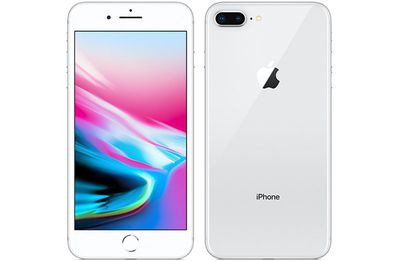
The iPhone 8 and the iPhone 8 Plus might look a lot like the iPhone 7 and the iPhone 7 Plus, but the glass body is a major distinguishing feature. According to Apple, the front and back glass is the most durable it's ever made. The two devices come in Silver, Space Gray, and a new shade of Gold that's a little bit rosier than the traditional gold shades.
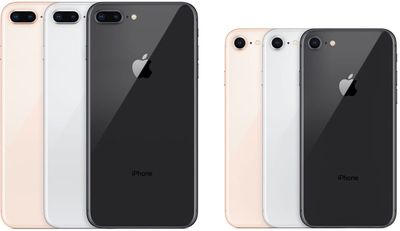
Apple used a seven-layer ink process to add color to the glass, giving the iPhone 8 and 8 Plus a rich depth of color. An oleophobic coating ensures that smudges and fingerprints wipe away easily.
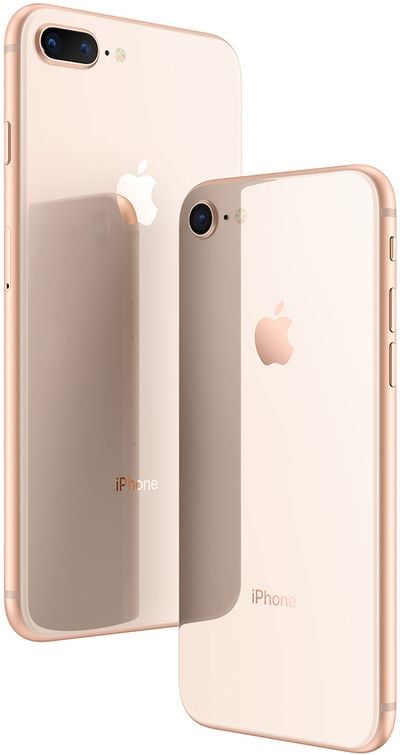
The glass shell and display are held together by a stainless steel internal frame and an aerospace-grade 7000 Series aluminum band that matches the color of each iPhone for a seamless look. Small, nearly invisible antenna lines cut through the aluminum frame to ensure adequate signal.

Though the iPhone 8 and iPhone 8 Plus use durable glass wrapped around a stainless steel internal frame, glass breaks when dropped on the ground, and the two devices have proven to be highly breakable when subjected to drop tests, even from heights as low as the waist.
On the left side of the iPhone 8 and 8 Plus, there's a mute switch and volume buttons, and the right side houses the sleep/wake button. At the bottom, there's a Lightning port and speaker holes. Like the iPhone 7 and iPhone 7 Plus, the two new devices have no headphone jack and require Lightning headphones or Bluetooth headphones.

Size wise, the iPhone 8 and the iPhone 8 Plus are ever so slightly larger than the iPhone 7 and iPhone 7 Plus. In usage, the size difference is tiny that it won't really be noticeable, but it's there.
The iPhone 8 measures in at 138.4mm tall by 67.3mm wide, and it's 7.3mm thick. Comparatively, the iPhone 7 is 138.8mm tall, 67.1mm wide, and 7.1mm thick.
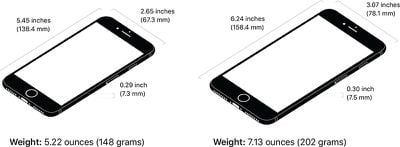
The iPhone 8 Plus measures in at 158.4mm tall by 78.1mm wide and it's 7.5mm thick. Comparatively, the iPhone 7 Plus is 158.2mm tall, 77.9mm wide, and 7.3mm thick.
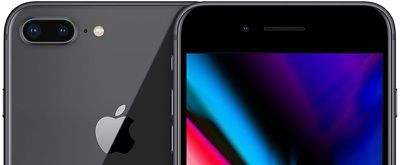
At the rear, the iPhone 8 continues to feature a single-lens protruding camera, while the iPhone 8 Plus features a wider dual-lens rear camera arranged in a horizontal orientation.
New (PRODUCT)RED Edition
Apple in April introduced a new (PRODUCT)RED iPhone 8 and iPhone 8 Plus, featuring a bright red glass-backed shell and a black front panel. Apple in 2017 introduced (PRODUCT)RED iPhone 7 and 7 Plus models, but those devices had a white front panel, so the new iPhone 8 is a deviation.
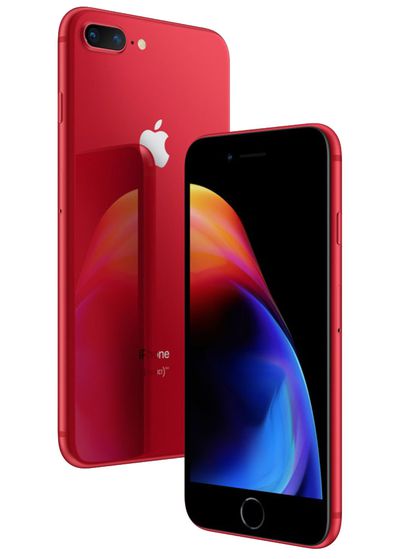
Apple's (PRODUCT)RED iPhone 8 and iPhone 8 Plus became available for purchase in April both online and in retail stores.
Water Resistance
Like the previous-generation iPhones, the iPhone 8 and the iPhone 8 Plus are water and dust resistant. An IP67 dust/water resistance rating means the two devices are entirely dust proof and able to withstand 1 meter of water (3.3 feet) for up to 30 minutes.
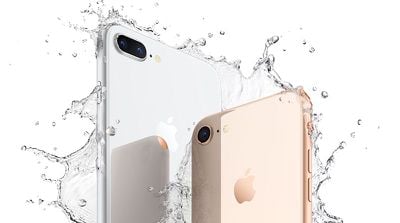
While the iPhone 8 and 8 Plus can stand up to splashes, rain, and brief accidental water exposure, but intentional water exposure should continue to be avoided. Apple warns that water and dust resistance are not permanent conditions and could decrease as a result of normal wear, plus Apple's warranty does not cover any kind of water damage to an iOS device.
Touch ID
While the iPhone X (which is being sold alongside the iPhone 8 and iPhone 8 Plus) features no Home button and thus no Touch ID, the iPhone 8 and iPhone 8 Plus both have Touch ID functionality, making them an excellent choice for customers not ready to give up fingerprint-based authentication in favor of the new facial recognition function in the iPhone X.

The Touch ID in the two devices is second-generation Touch ID that's super fast and accurate. Touch ID is used as a biometric authentication method for unlocking the iPhone, confirming iTunes purchases, opening passcode-protected apps, and confirming Apple Pay payments.
Display
The iPhone 8 features a 4.7-inch display with a resolution of 1334 by 750 with 326 pixels per inch and a 1400:1 contrast ratio, while the iPhone 8 Plus features a 5.5-inch display with a 1920 by 1080 resolution, 401 pixels per inch, and a 1300:1 contrast ratio.
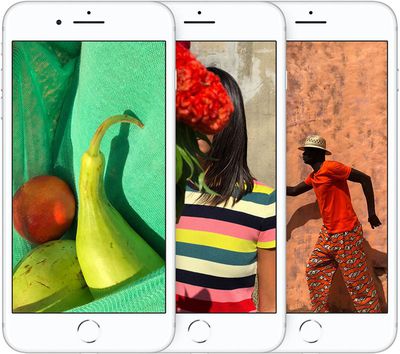
Both devices offer support for P3 wide color for rich, true-to-life colors and 625 cd/m2 max brightness, identical to the previous-generation iPhone 7 and iPhone 7 Plus.
True Tone
New in the iPhone 8 and 8 Plus is the True Tone feature that was first introduced in the iPad Pro. True Tone uses the ambient light sensor to detect the lighting in a room, adjusting the color temperature and intensity to match the light for a more natural viewing experience.
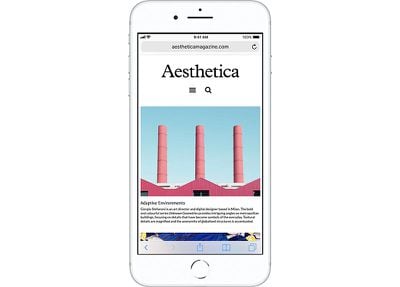
True Tone is designed to make the iPhone's display appear more paper-like when reading for more comfort and less eyestrain.
A11 Bionic Processor
Apple says the A11 Bionic processor in the iPhone 8 and 8 Plus is the most powerful and smartest chip that's ever been introduced in a smartphone. It features a six-core CPU with two high performance cores and four high efficiency cores.
The two A11 cores are 25 percent faster than the A10 chip in the iPhone 7, while the four high-efficiency cores are 70 percent faster.
All four cores can be harnessed at the same time with a second-generation performance controller resulting in 70 percent better performance for multi-threaded workflows.
In early Geekbench benchmarks, the A11 earned an average single-core score of 4169 and an average multi-core score of 9836. The A11 outperforms the A10X in the iPad Pro and even the dual-core processor in the 2017 13-inch MacBook Pro models.
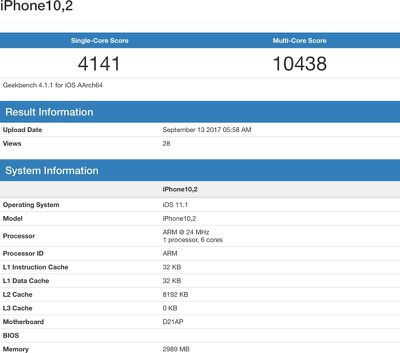
The A11 chip includes a new Apple-designed three-core CPU that's 30 percent faster than the GPU in the A10 chip, introducing much improved graphics performance. There's also an embedded M11 Motion coprocessor that captures motion-based data from the compass, accelerometer, and gyroscope to power fitness capabilities, augmented reality experiences, and more, without significant power drain.
Two of the efficiency cores make up the Neural Engine, designed to process machine learning tasks.
RAM
There's 2GB of RAM in the 4.7-inch iPhone 8 and 3GB of RAM in the 5.5-inch iPhone 8 Plus. The iPhone 8 Plus has more RAM to support the dual-lens camera and the Portrait Mode features.
Inductive Wireless Charging
The glass bodies of the iPhone 8 and iPhone 8 Plus enable an inductive wireless charging feature, which is new to Apple's iOS device lineup. Apple has adopted the Qi open wireless charging standard that's built into many Android devices, so the iPhone 8 and 8 Plus can charge wirelessly using any Qi-certified charging accessory.
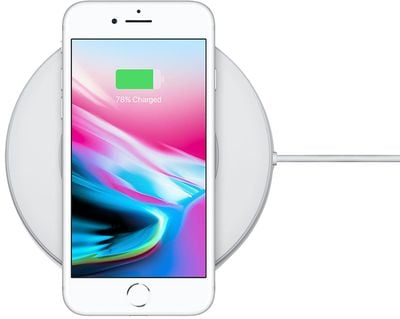
Qi charging is inductive, which means the iPhone 8 and iPhone 8 Plus must be placed on a charging mat or similar accessory to be able to charge. While physical contact is required, the wireless charging feature works with most cases.
As of iOS 11.2, the iPhone X, iPhone 8, and iPhone 8 Plus support faster 7.5W wireless charging using compatible third-party wireless chargers. Not all wireless chargers support 7.5W, so it's best to make sure wattage is listed before making a purchase.
In our testing, which compared several wired and wireless charging methods, wireless charging is similar to charging with the standard 5W iPhone charger, but it is slower than other charging methods, such as charging with the 12W iPad adapter and USB-C fast charging.
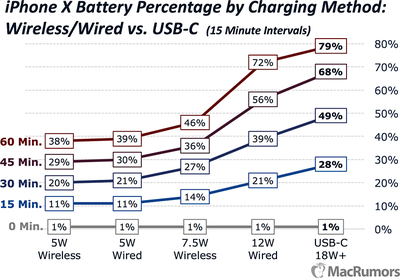
7.5W wireless charging is faster than 5W wireless charging in some cases using supported 7.5W chargers, but there are a lot of factors that influence the speed of wireless charging so the difference isn't always evident. Wireless charging is convenient and best suited to overnight charging and situations where you don't immediately need an infusion of power.
Because the Qi standard has been available for several years, there are plenty of wireless charging accessories already available for purchase, plus companies like Belkin and Mophie have made chargers specifically for Apple devices. We have a dedicated roundup reviewing more than a dozen of the wireless chargers currently on the market, and it's worth checking out if you're shopping for a wireless charger for iPhone 8.

Qi charging functionality is also available in cafes, restaurants, coffee shops, airports, and other locations around the world, and now that Apple has adopted the standard, Qi charging locations are seeing a more rapid rollout. Qi-based chargers are also available in many newer vehicles, and Apple has released a support document outlining vehicles with compatible chargers. Most should work, but there can be size constraints with the larger iPhone 8 Plus.
Cameras
The iPhone 8 features a more advanced 12-megapixel wide-angle f/1.8 camera with a larger, faster sensor that lets in 83 percent more light. Other features include a new color filter and deeper pixels for better color saturation, a wider dynamic range of color, and lower noise in photos and videos.

A new Apple-designed image signal processor introduces faster autofocus in low light, new pixel processing techniques for sharpness and texture, and hardware-enabled multi-band noise reduction. The image signal processor also detects people, motion, and lighting conditions in a scene to optimize photos before they're taken.
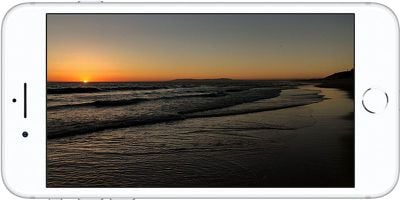
Optical image stabilization also helps improve photos in low light and when capturing video.
There's a quad-LED True Tone Flash with a Slow Sync feature that combines a slow shutter speed with a strobe pulse for a brighter foreground subject and properly exposed background in low lighting conditions. The flash also offers more uniform illumination for better performance all around.
iPhone 8 Plus - Dual Cameras
The iPhone 8 Plus features a dual-lens camera arrangement with the same upgraded wide-angle camera that's in the iPhone 8 paired with an f/2.8 telephoto camera that enables Portrait Mode for the sharp foregrounds and artfully blurred backgrounds normally only possible with a DSLR.
With improvements in the iPhone 8 Plus, there's sharper detail, more natural background blurring, better performance in low light, and support for flash.
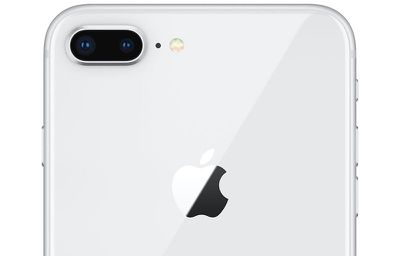
New to Portrait Mode in the iPhone 8 Plus is a new Portrait Lighting feature that lets you add studio quality lighting effects to your images. To enable Portrait Lighting, the two cameras create a depth map of an image, using machine learning techniques to mark the presence of a face and how the light in a scene interacts with the face.
Using that info, the iPhone 8 Plus is able to manipulate the lighting as you take a photo using realtime analysis. Lighting can also be changed in the Photos app after a photo has been taken.
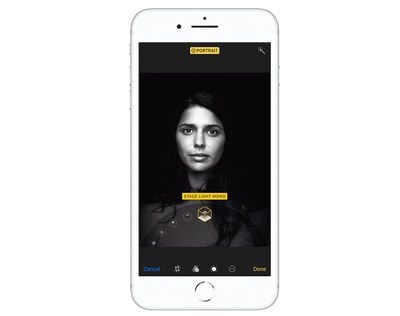
Portrait Lighting effects include Natural Light, Studio Light (lights up your face), Contour Light (adds dramatic shadows), Stage Light (spotlights your face against a dark background), and Stage Light Mono (Stage Light, but in black and white).
Video
Apple says the iPhone 8 and 8 Plus support the highest quality video capture ever. Along with the image signal processor that reduces noise and allows autofocus to work more quickly in low light, there's also a new Apple-designed video encoder that enables faster video frame rates and real-time image and motion analysis that can predict changes in content to optimize video encoding algorithms.
4K video recording is available at 24, 30, or 60 frames per second, as is 1080p video recording at 30 or 60 fps.
Slo-mo video support for 1080p at either 120 or 240 fps is also supported.
FaceTime Camera
At the front of the iPhone 8 and 8 Plus, there's a 7-megapixel f/2.2 aperture FaceTime HD camera for selfies and FaceTime conversations. The camera includes wide color capture, auto image stabilization, 1080p HD video recording, and Retina Flash that uses the display.

Battery Life
The iPhone 8 has an 1,821mAh battery, while the iPhone 8 Plus has a 2,675 mAhbattery. That's smaller than the 1,960mAh and 2,900 mAh batteries found in the iPhone 7 and iPhone 7 Plus, but there is no difference in battery life due to other optimizations.
The iPhone 8 offers up to 14 hours of talk time, 12 hours of internet use, 13 hours of video playback, and 40 hours of audio playback.
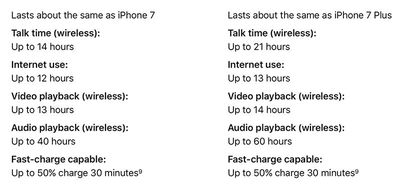
The iPhone 8 Plus offers up to 21 hours of talk time, 13 hours of internet use, 14 hours of video playback, and 60 hours of audio playback.
The iPhone 8, iPhone 8 Plus, and iPhone X use a "different performance management system" than older iPhones, which means any performance management features may be less noticeable on these devices.
The three devices use a more advanced hardware and software design that's better able to estimate power needs and battery performance, so in the future, they made not need the same processor-throttling performance management features implemented in older iPhones.
Fast Charging
The iPhone 8 and 8 Plus are "fast-charge capable," meaning they can be charged to 50 percent battery life in 30 minutes. Fast charging requires the iPhone 8 to be plugged into Apple's 29W, 61W, or 87W USB-C Power Adapters, which are sold alongside its USB-C MacBook and MacBook Pro models.
A USB-C to Lightning cable is also required to go along with the USB-C Power Adapter, and the minimum price for those accessories is $74.
Augmented Reality
The iPhone 8 and 8 Plus have bene designed with augmented reality apps in games in mind, with the A11 Bionic chip handling world tracking and scenes while the GPU renders realistic graphics. A new image signal processor handles real-time lighting estimation, the cameras have been calibrated for augmented reality with 4K 60 fps support and improved low light capabilities, while a new gyroscope and accelerometer enable more accurate motion tracking.
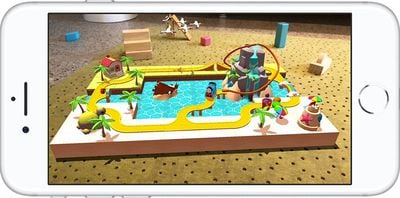
All of these new features are designed to support the wealth of augmented reality apps built with Apple's ARKit and introduced in iOS 11. iPhone 8 and iPhone 8 Plus deliver an unparalleled augmented reality experience and ARKit makes the iPhone and the iPad the largest AR platform in the world.
Other Features
Speakers
Redesigned stereo speakers are up to 25 percent louder than the speakers in the iPhone 7 and feature deeper bass. There are two speakers in the device, one at the top and one at the bottom.
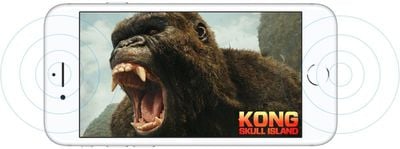
LTE
The iPhone 8 and the iPhone 8 Plus support LTE Advanced for data transfer speeds up to 600Mb/s. There are more than 20 LTE bands available, which makes the two devices more likely to be able to work with networks in other countries when traveling.
As with the previous-generation iPhone 7 and the iPhone 7 Plus, Apple is using both Intel and Qualcomm chips, some of which are not compatible with the CDMA networks of Verizon and Sprint in the United States.
T-Mobile and AT&T iPhone 8 models are not compatible with the Verizon and Sprint because they only work with GSM networks. Verizon and Sprint iPhone 8 models. support both GSM and CDMA networks and are compatible with T-Mobile and AT&T.
Models A1863 and A1864 support GSM and CDMA and are designed for Sprint/Verizon, while Models A1905 and A1897 do not support CDMA networks.
Verizon and Sprint devices appear to use Qualcomm's X16 Snapdragon gigabit-class modem, while AT&T and T-Mobile use Intel's XMM 7480 modem. Both modems feature performance improvements and have likely been selected due to their improvements to power efficiency, allowing Apple to cut down on battery size while maintaining the same battery life.
Qualcomm's X16 modem brings 4x carrier aggregation with a total bandwidth of up to 80 MHz and gigabit-level peak theoretical speeds, while the Intel XMM 7480 offers a peak theoretical speed of 600Mb/s and 4x carrier aggregation with two channels limited to 10 MHz for overall bandwidth of 60 MHz.
Ookla LTE speed tests conducted on a range of iPhone 8 and 8 Plus models in the United States and a few other countries have demonstrated modest LTE speed improvements compared to previous-generation devices. Improvements appear to be around the 10 percent mark for most users, but up there are speed improvements up to 25 percent in Australia due to a different network structure used in the country.
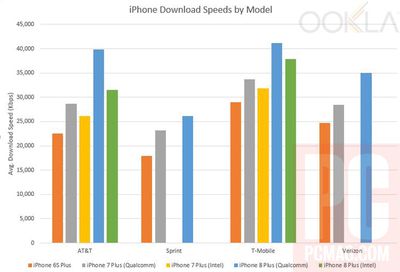
Wi-Fi
The iPhone 8 and 8 Plus support 802.11a/b/g/n/ac Wi-Fi with MIMO. The technology is the same as the Wi-Fi technology in the iPhone 7 and 7 Plus, with connection speeds that can reach a theoretical maximum of 866Mb/s.
Bluetooth, NFC, and GPS
Support for the new Bluetooth 5.0 standard is built into the iPhone 8 and 8 Plus. Bluetooth 5.0 offers four times the range, two times the speed, and eight times the broadcast message capacity compared to the previous Bluetooth 4.2 standard.
In addition to the Global Positioning System operated by the U.S. government, the iPhone 8 and 8 Plus add support for Galileo, Europe's Global Satellite Navigation System, and QZSS, the Quasi-Zenith Satellite System used in Japan.
Galileo support in the new iPhones allows users to benefit from more precise positioning that's able to combine GPS, GLONASS, and Galileo signals. Galileo, says the agency, has a modern signal structure that's able to help users better maintain their position fix when navigating through cities worldwide.
As for NFC, there's a new NFC chip with reader mode support that lets the iPhone 8 and 8 Plus read NFC tags installed in places like retail stores, museums, and more.

